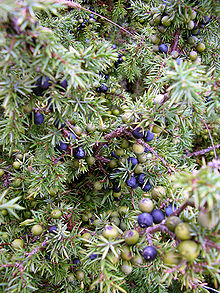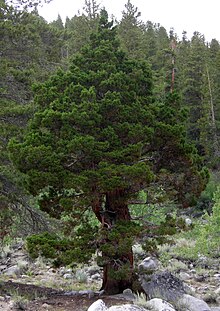JUNIPER BERRIES
Juniperus communis
A juniper berry is the female seed cone produced by the various species of junipers. It is not a true berry but a cone with unusually fleshy and merged scales, which give it a berry-like appearance. The cones from a handful of species, especially Juniperus communis, are used as a spice, particularly in European cuisine, and also give gin its distinguishing flavour. According to one FAO document, juniper berries are the only spice derived from conifers,though tar and inner bark (used as a sweetener in Apache cuisines) from pine trees is sometimes considered a spice as well.
 |
| A few dried berries can be chewed and taste good |
 |
| uniper berries, here still attached to a branch, are actually modified conifer cones. |
 |
| Mature purple and younger green juniper berries can be seen growing alongside one another on the same plant. |
Part used: fruit.
Properties: antispasmodic, diuretic, anodyne, aromatic, astringent, carminative, lithotriptic, stimulant.
What it affects: Kidneys and stomach.
Preparation and amount:
Infusion: Steep 5-15 min. and drink 3 oz. 1-3 time a day.
Decoction: Simmer 5-15 min and drink 1-2 cups every day.
Tincture: drink 5-20 drops 3 time a day.
Fluid extract: Drink 1/2-1 tsp. 3 x day.
Oil: drink 1-3 drops 2 x a day.
Powder: Take up to 10 #0 capsules (up to 60 grains) daily.
Purposes:
Internally, juniper berries act as a stimulating diuretic and are beneficial in the treatment of urine retention, catarrh of the bladder, gravel, and pains in the lower back. It is also good for bladder discharges and uric acid buildup. Take 1-3 drops of the oil, plus honey, 2 time a day. It is usually taken internally by eating the berries or making a tea from them. The berries eliminate excess water. The tea is good douche for vaginal infections. It is helpful in the treatment of asthma, fluid retention, and prostate disorders. It is also used for diabetes, cystitis, bladder diseases, allergies, arthritis, bed- wetting, hay fever, lumbago, and nephritis.
Juniper berries are used for gastro-intestinal infections and cramps, leukorrhea, gonorrhea, gouty and rheumatic pains. It is an excellent digestive tonic. It helps in case of reduced production of stomach acid (hydrochloric acid) and in regulating blood sugar levels.
As a spice, the berries are used to enhance flavor, stimulates appetite, and counteract flatulence. The berries can be made into a jam or syrup as an appetizer. A few dried berries can be chewed and taste good.
Externally, juniper oil, derived from the berries, penetrates the skin easily and is good for bone and joint problems. Inhaled in a vapor bath, it is used for bronchitis and infection in the lungs. The berries can be boiled and then spray in a room where sick people have been, to disinfect it. It is said that those who are nursing patients with serious diseases should chew berries, to protect themselves from pathogenic substances with might be inhaled.
Warning:
Large doses of juniper berries can be irritating to the kidneys and urinary passages. It may interfere with the absorption of iron and certain other minerals. It should not be used during pregnancy, nor by persons with kidney disease. It should not be used for a lengthy period of time by those with urinary tract or inflammatory diseases. The pure oil, placed on the skin in large quantities, can cause inflammation and blisters.
Plant Description:
 |
| Juniper berry tree |
Junipers vary in size and shape from tall trees, 20–40 m tall, to columnar or low spreading shrubs with long trailing branches. They are evergreen with needle-like and/or scale-like leaves. They can be either monoecious or dioecious. The female seed cones are very distinctive, with fleshy, fruit-like coalescing scales which fuse together to form a "berry"-like structure, 4–27 mm long, with 1-12 unwinged, hard-shelled seeds. In some species these "berries" are red-brown or orange but in most they are blue; they are often aromatic and can be used as a spice. The seed maturation time varies between species from 6–18 months after pollination. The male cones are similar to those of other Cupressaceae, with 6-20 scales; most shed their pollen in early spring, but some species pollinate in the autumn.
No comments:
Post a Comment